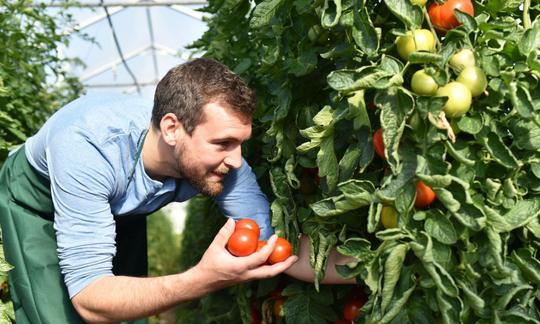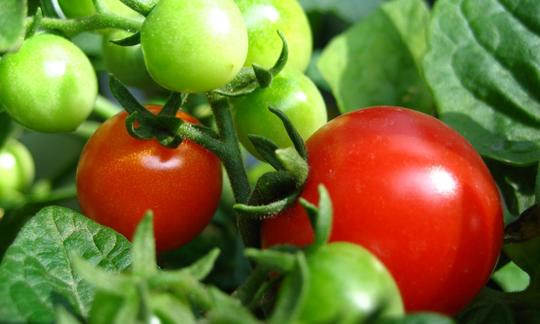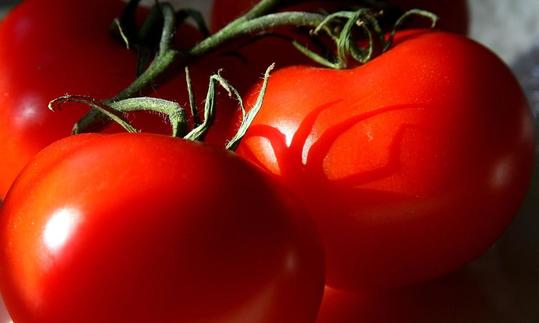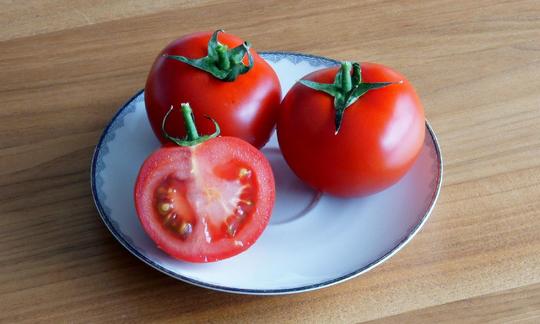Table of contents
Ripe, red tomatoes ( Solanum lycopersicum ) are an extremely popular vegetable. They can be eaten raw (preferably organic ) or cooked and are very versatile.
Use in the kitchen
Hardly any other fruit or vegetable has as many uses as tomatoes. Can you eat tomatoes raw? They are used raw in cold dishes and boiled, blanched, steamed, grilled and baked in hot dishes. They are also often processed into tomato paste , tomato juice and tomato ketchup . Tomatoes taste different depending on the variety and quality, as well as the way they are grown and the climate. A good, ripe, red tomato has a balanced ratio of acidity and sweetness when raw and tastes pleasantly aromatic. There are countless types of tomatoes that differ in shape, color and size - you can find small tomatoes like the cherry tomato (strictly speaking a variety) or even green varieties like the Green Zebra. In this article we focus on red, ripe tomatoes in standard size.
The raw tomato is particularly suitable for salads, e.g. with vegan mozzarella and basil (vegan Caprese) or red onions ; also for cold vegetable soups ( gazpacho ), as a side dish, in vegan sandwiches, wraps and burgers or simply as a raw food snack (comparable to an apple ). Here are a few recommended recipes with raw tomatoes:
- Tomato-avocado carpaccio with poppy seed-lime dressing
- Raw pasta with tomato sauce, spicy nut balls and walnut "parmesan cheese"
- Raw chili with mushrooms and wild garlic
- Cauliflower tabbouleh with tomatoes, olives and herbs
Cooked tomatoes can be used in all kinds of tomato sauces (e.g. for pasta, lasagne or pizza), soups (e.g. tomato soup, quick red lentil soup with tomatoes, ginger and chilli ) or simply as a vegetable in vegetarian and vegan dishes. Tomato risotto, ratatouille, Indian tomato curries and shakshuka also require tomatoes as an ingredient and taste wonderful. Tomatoes stuffed with rice , millet or quinoa , tomatoes baked with garlic or vegan African stews (e.g. with kidney beans , peanut butter, garlic and cumin ) are also recommended dishes. In addition, the flesh of the tomatoes can be processed into various tomato spreads (e.g. with sweet peppers or with walnuts (pesto rosso)) or into tomato salsa (e.g. for chips).
Raw vegan recipe for Moroccan tomato and cucumber salad
Ingredients (for 2 people): 4 ripe tomatoes (red, raw, organic), 1 cucumber , 2-3 tablespoons fresh lemon juice , 3 tablespoons rapeseed oil , 1 teaspoon ground cumin , 2 pinches of sugar , 3 sprigs of fresh peppermint , some salt andpepper , olives as desired.
Preparation: Rinse the raw tomatoes and cucumber, dice them and put them in a bowl. Season with salt, mix and leave to stand for 20-30 minutes. Drain off the water. For the dressing, mix the lemon juice, oil, cumin, sugar and pepper well. Rinse the peppermint, shake dry and chop. Add the dressing and chopped peppermint to the diced tomatoes and cucumber and mix everything together. Add olives as desired and season with salt and pepper. This goes well with fresh, still warm flatbread.
Vegan recipes with tomatoes (red, ripe, raw) can be found under the note: " Recipes that have the most of this ingredient ".
| Not only vegans or vegetarians should read this: Vegans often eat unhealthily. Avoidable nutritional mistakes . |
Shopping - Storage
Can you buy tomatoes all year round? Tomatoes are available in all supermarkets (e.g. Coop , Migros , Denner , Volg , Spar , Aldi , Lidl , Rewe , Edeka , Hofer , Billa etc.) and organic supermarkets (e.g. Alnatura , Denn's Biomarkt ) all year round, both conventional and organic. The greenhouse tomatoes available in winter are usually not as aromatic as the sun-ripened tomatoes grown outdoors. Tomatoes are in season in the DA-CH countries from April to November . 10 We recommend going to the weekly market in midsummer. There you will find a variety of beautiful and flavorful tomatoes.
The availability of red, ripe tomatoes varies depending on the size of the store, catchment area, etc. If you are interested, click on our recorded food prices for the DA-CH countries (above under the ingredient image). There you will find current prices from various supermarkets and their price development.
Storage tips
Store raw tomatoes at room temperature. This way they will last for up to a week. They should not be stored in the fridge as this will not only have a negative effect on the taste and shelf life but also on the ingredients. Store tomatoes separately from other products. They emit the plant hormone ethene (ethylene) and cause fruit or vegetables stored nearby to ripen more quickly.
Ingredients - Nutritional values - Calories
How many calories do tomatoes have? With 18 kcal and 0.2 g fat per 100 g, tomatoes are very low in calories and fat. Do tomatoes contain carbohydrates? Carbohydrates (3.9 g/100g) and proteins (0.88 g/100g) are also sparsely present. The raw tomato consists of about 95% water and contains some vitamins and minerals. 2
100 g of raw tomatoes contain 14 mg of vitamin C - this covers 17% of the daily requirement. Radishes (15 mg/100g) and fennel (12 mg/100g) contain a similar amount. The yellow bell pepper is particularly rich in vitamin C with 184 mg/100g. 2
The potassium content is 237 mg/100g (12% of the daily requirement).Lettuce , Chinese cabbage and pomegranate have similar contents. Dried herbs and spices contain many times more potassium, such as dried coriander leaves with 4,466 mg/100g (= 44.66 mg/1g). 2 However, it is important to remember to use small amounts of spices and dried herbs. Spinach has a little more potassium than fresh vegetables, with 558 mg/100g.
Do tomatoes contain vitamin K? Raw tomatoes also contain vitamin K. The content of 7.9 µg/100g is similar to that in green bell peppers (7.4 µg/100g) andraspberries (7.8 µg/100g). With 830 µg of vitamin K per 100 g, chard contains over 100 times as much. 2
The total ingredients of the tomato (red, ripe), the coverage of the daily requirement and comparison values with other ingredients can be found in our nutrient tables. In the article Nutrients explained you will get a detailed insight into the topic.
Health effects
Do tomatoes contain nutrients? Tomatoes are rich in nutrients and other bioactive compounds that are important or useful for human health. 6 For example, they have a pronounced antioxidant, anti-inflammatory and anti-cancer effect. 3 One of the most important contributions to the nutrient content of tomatoes is carotenoids. Carotenoids (such as lycopene, which gives tomatoes their red color) act as antioxidants and scavengers for reactive oxygen species. In this way, they prevent damage to the genetic material caused by free radicals. They block uncontrolled and excessive cell growth and protect against cancer. 5,6
In addition to the link between the consumption of tomatoes and tomato products and the reduction in the risk of cancer, recent research also shows a reduced risk of diseases such as obesity, hyperglycemia, hypercholesterolemia and cardiovascular disease. 7,8
Dangers - Intolerances - Side effects
The beneficial or harmful effects of tomatoes and tomato products are closely related to the presence and amount of various biologically active compounds. Particularly noteworthy are carotenoids, potassium, some proteins, organic acids and glycoalkaloids (tomatin or solanine). Therefore, the effects of these compounds vary depending on individual consumption. 3
The glycoalkaloid tomatine (also known non-specifically as solanine 18 ) is considered harmful to health. However, the amounts contained in ripe tomatoes are usually extremely small. While unripe tomatoes contain around 500 mg of tomatine per kg, it is hardly found in ripe fruit (around 5 mg/kg). This means that no symptoms of poisoning occur 4 and eating ripe tomatoes is safe 18 . You should only be careful when consuming products made from green, unripe tomatoes (such as jam or pickled tomatoes). 18
For a long time, people suffering from kidney stones were advised to avoid tomatoes because of their oxalic acid content; oxalic acid forms insoluble salts with calcium, which precipitate as stones. But tomatoes contain very little oxalic acid and are therefore also edible for people with kidney disease. 5
For some people with sensitive stomachs, cooked tomatoes are difficult to digest. 5
Risk of confusion
Red tomatoes can resemble the red fruits of the bittersweet nightshade ( Solanum dulcamara ), a poisonous plant from the same botanical family. This has given the tomato a false reputation for also being poisonous. 5
Folk medicine - natural medicine
What are tomatoes good for? At the beginning of the 20th century, tomatoes were used in folk medicine on the American continent as a remedy for dyspepsia (pain in the upper abdomen), liver problems and kidney diseases. 9
In addition, the tomato had the reputation of acting as an aphrodisiac, as the French name "pomme d'amour" and the English name "love apple" suggest.
Ecological footprint - animal welfare
The CO 2 footprint of tomatoes depends heavily on the cultivation system and regionality. Tomatoes are often grown in greenhouses, especially when the regional climate is too cold. Heating the greenhouses allows the heat-loving plants to be grown all year round. Alternatively, foil tunnels are used or the tomatoes are grown outdoors, which drastically reduces the amount of energy required. 14 Seasonal, regional tomatoes have an average CO 2 footprint of 0.3 kg CO 2 eq/kg, regional tomatoes from the greenhouse (out of season) show a value of 2.9 kg CO 2 eq/kg. 15 It is therefore best to buy during the season and, if possible, make sure that they are "outdoor tomatoes" from the region. Tomatoes from Switzerland often come from greenhouses, as they need warmth and must be protected from wind and rain. 10
The amount of water required to produce 1 kg of tomatoes also depends on various factors and varies greatly in the literature. The values range between 214 and 1000 litres of water-eq/kg of tomatoes. 15,16 In contrast to the amount of emissions emitted, the amount of water required for 1 kg of tomatoes from the greenhouse is on average lower than for 1 kg of tomatoes from the open field. This is a key factor, especially in dry regions. It is important to mention here that the tomatoes in such glass or plastic greenhouses grow in soilless substrates with nutrient solutions. In foil tunnels or open fields, on the other hand, the tomatoes grow in the soil and receive not only green manure but also organic-mineral fertilization. 17
The enormous demand for tomatoes led to unecological mass cultivation with a larger ecological footprint and at the same time to a decrease in quality. In conventional cultivation, hybrid tomatoes are usually grown in hydroponics or on substrate blocks (glass wool enriched with nutrients). Although hybrid varieties also exist in organic cultivation (organic), chemical and synthetic pesticides and fertilizers are not used. 13
Worldwide occurrence - cultivation
The tomato originally comes from South America. 10 Spaniards brought it to Europe from Peru and Mexico in the 16th century. 5 Today, tomatoes are at the top of the list of global vegetable production. The global annual production of tomatoes in 2018 was around 182.3 million tons, of which the processing industry used around a quarter. Fresh tomatoes are mainly produced in temperate zone countries, especially in the northern hemisphere. 6 Major growing countries include Italy, Russia, Turkey and the USA. 11
Tomato processing takes place in almost all countries, but consumption of processed tomatoes is limited to countries with a higher standard of living. According to the economic data collected, the tomato is indisputably the most consumed vegetable in terms of trade, volume and commercial value. Tomato paste is the most important product in terms of both volume and value, followed by canned tomatoes (whole, in pieces, peeled or unpeeled) and tomato ketchup. 6
Wild
Tomatoes can be found in tropical and subtropical areas. Different varieties have been created through cross-breeding with close relatives, cultivated varieties and wild species. These look very diverse - they are usually small, green and sometimes hairy fruits. 1
Growing your own - Harvesting
tomatoes is easy to grow yourself - in pots on the balcony, in the greenhouse or in the garden. When growing in pots (at least 10 l capacity), you should choose small-growing varieties. Tomatoes prefer well-loosened, humus- and nutrient-rich soil and a sunny, warm and wind-protected location. They are sensitive to waterlogging. 12
It is best to grow tomato plants indoors or under glass. Sowing should take place at the end of February, or at the latest between the end of March and the beginning of April. Eight to ten days later, the seeds will begin to germinate if placed in a bright and warm place. After about three weeks, when the seedlings have developed the first pair of leaves (not cotyledons), the young plants can be transplanted. Larger seedlings are also available in garden centers. Tomatoes do not tolerate frost and should therefore not be planted outdoors until around mid-May, after the "Ice Saints". 12
After planting, you should water them thoroughly, but avoid watering them for the next few days to encourage the plants to grow roots. After that, you can water the plants sparingly. Since tomatoes need a lot of nutrients, you should feed them with a natural, organic fertilizer every 14 days (e.g. homemade nettle or comfrey manure). 12
With the exception of bush tomatoes, all types of tomatoes need a climbing aid - spiral rods made of aluminum or stainless steel are particularly easy to clean. It is best to stick the rods into the soil when planting. This way, you can continuously twist the growing main shoots through the windings to fix them in place. 12
When are tomatoes ripe? The first tomatoes grown outdoors are ready to eat at the end of July. Tomatoes grown in greenhouses are usually ready to harvest a month earlier. Red tomatoes continue to ripen a little if kept indoors. 12
Tomato plants should be planted in a new bed every year, otherwise pests and plant pathogens can multiply in the soil. 12
Further information
The tomato ( Solanum lycopersicum ) belongs to the nightshade family (Solanaceae). From a botanical point of view, the fruits are berries. 11
Tomatoes are differentiated according to growth and fruit shape and are divided into categories, e.g.: 12
- Stake tomatoes (long main stem)
- Bush or balcony tomatoes (bushy growth and limited height)
- Beefsteak tomatoes (large, ribbed fruits)
- Cherry tomatoes (small, cherry-shaped fruits and a variety of their own)
- Cocktail tomatoes (for the distinction between the last two, see the ingredient cherry tomatoes ).
There are over 2500 varieties of tomatoes that differ in shape, color, size and taste. 10
Alternative names
In colloquial language, the tomato is also called paradise apple, paradeiser, paradeis or love apple.
In English, the tomato is called a tomato, occasionally a love apple.
Bibliography - 18 Sources
| 1. | Tomaten-aus-kurpfalz.de Die wilde Tomate – die Wildtomate. |
| 2. | USDA United States Department of Agriculture. |
| 3. | Salehi B, Sharifi-Rad R, Sharopov F et al. Beneficial effects and potential risks of tomato consumption for human health: An overview. Nutrition. 2019;62:201-208. |
| 4. | Friedman M. Tomato glycoalkaloids: role in the plant and in the diet. J Agric Food Chem. 1. Oktober 2002;50(21):5751–80. |
| 5. | Pamplona-Roger JD. Heilkräfte der Nahrung. Advent-Verlag: Zürich. 2006: 264-7. |
| 6. | Vats S, Bansal R, Rana N et al. Unexplored nutritive potential of tomato to combat global malnutrition. Crit Rev Food Sci Nutr. 2022;62(4):1003-1034. |
| 7. | Perveen R, Suleria HAR, Anjum FM, Butt MS, Pasha I, Ahmad S. Tomato (Solanum lycopersicum) carotenoids and lycopenes chemistry; metabolism, absorption, nutrition, and allied health claims--a comprehensive review. Crit Rev Food Sci Nutr. 2015;55(7):919-929. |
| 8. | Cheng HM, Koutsidis G, Lodge JK, Ashor A, Siervo M, Lara J. Tomato and lycopene supplementation and cardiovascular risk factors: A systematic review and meta-analysis. Atherosclerosis. 2017;257:100-108. |
| 9. | Deutsche-apotheker-zeitung.de Tomate: Sieht gut aus, schmeckt lecker und ist gesund. |
| 10. | Gemuese.ch Tomate. |
| 11. | Brücher H. Tropische Nutzpflanzen. Ursprung, Evolution und Domestikation. Springer-Verlag Berlin Heidelberg: New York; 1977: 380-93. |
| 12. | Mein-schoener-garten.de Tomaten. |
| 13. | Pini U. Das Bio-Food Handbuch. Ullmann Verlag: Potsdam; 2014: 748-9. |
| 14. | Müller-Lindenlauf M, Zipfel G, Rettenmaier N, Gärtner S, Münch J, Paulsch D, Reinhardt G. CO2-Fussabdruck und weitere Umweltwirkungen von Gemüse aus Baden-Württemberg. 2013. |
| 15. | Reinhardt G, Gärtner S, Wagner T. Ökologische Fussabdrücke von Lebensmitteln und Gerichten in Deutschland. Institut für Energie - und Umweltforschung Heidelberg. 2020. |
| 16. | Mekonnen MM, Hoekstra AY. The green, blue and grey water footprint of crops and derived crop products. Hydrol. Earth Syst. Sci. 2011; 15: 1577-1600. |
| 17. | Boulard T, Raeppel C, Brun R et al. Environmental impact of greenhouse tomato production in France. Agronomy for Sustainable Development 31. 2011; 757-777. |
| 18. | Weiss C. Glykoalkaloide in Kartoffeln und Tomaten. Ernährungs Umschau. 2007;8:474-477. |

















Comments